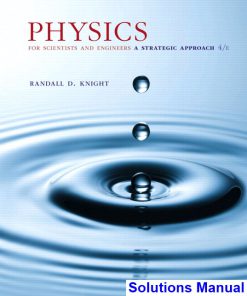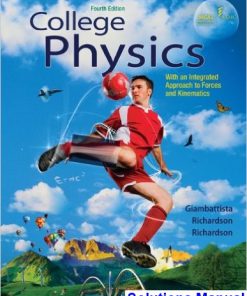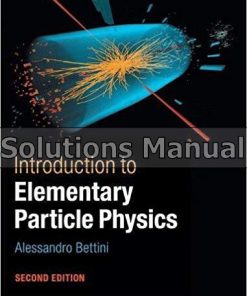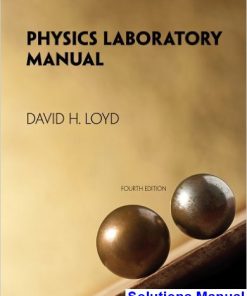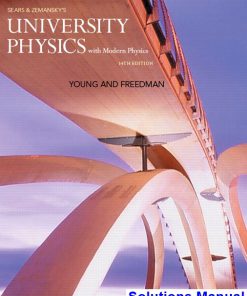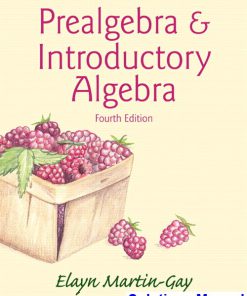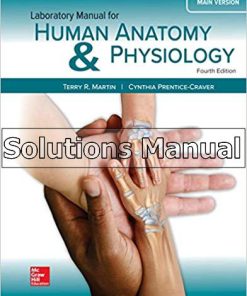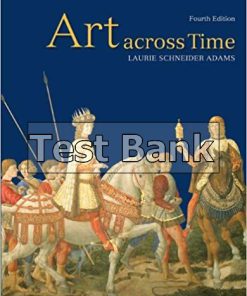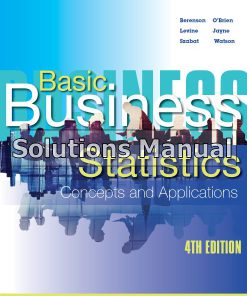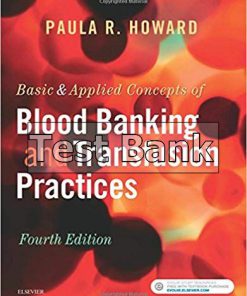Particle Physics 4th Edition Martin Solutions Manual
$50.00 Original price was: $50.00.$26.50Current price is: $26.50.
Particle Physics 4th Edition Martin Solutions Manual.
Particle Physics 4th Edition Martin Solutions Manual
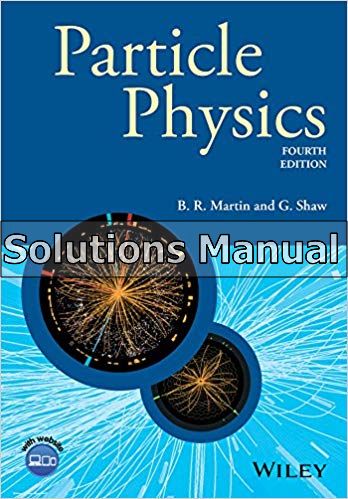
Product details:
- ISBN-10 : 1118912160
- ISBN-13 : 978-1118912164
- Author: Brian Martin
An accessible and carefully structured introduction to Particle Physics, including important coverage of the Higgs Boson and recent progress in neutrino physics.
- Fourth edition of this successful title in the Manchester Physics series
- Includes information on recent key discoveries including: An account of the discovery of exotic hadrons, byond the simple quark model; Expanded treatments of neutrino physics and CP violation in B-decays; An updated account of ‘physics beyond the standard model’, including the interaction of particle physics with cosmology
- Additional problems in all chapters, with solutions to selected problems available on the book’s website
- Advanced material appears in optional starred sections
Table contents:
1 Some basic concepts 1
1.1 Introduction 1
1.2 Antiparticles 3
1.2.1 Relativistic wave equations 3
1.2.2 Hole theory and the positron 6
1.3 Interactions and Feynman diagrams 9
1.3.1 Basic electromagnetic processes 10
1.3.2 Real processes 11
1.3.3 Electron–positron pair production and annihilation 13
1.3.4 Other processes 15
1.4 Particle exchange 15
1.4.1 Range of forces 15
1.4.2 The Yukawa potential 17
1.4.3 The zero-range approximation 18
1.5 Units and dimensions 19
Problems 1 22
2 Leptons and the weak interaction 24
2.1 Lepton multiplets and lepton numbers 24
2.1.1 Electron neutrinos 25
2.1.2 Further generations 28
2.2 Leptonic weak interactions 31
2.2.1 W± and Z0 exchange 31
2.2.2 Lepton decays and universality 33
2.3 Neutrino masses and neutrino mixing 35
2.3.1 Neutrino mixing 35
2.3.2 Neutrino oscillations 38
2.3.3 Neutrino masses 46
2.3.4 Lepton numbers revisited 48
Problems 2 50
3 Quarks and hadrons 52
3.1 Quarks 53
3.2 General properties of hadrons 55
3.3 Pions and nucleons 58
3.4 Strange particles, charm and bottom 61
3.5 Short-lived hadrons 66
3.6 Allowed and exotic quantum numbers 72
Problems 3 75
4 Experimental methods 77
4.1 Overview 77
4.2 Accelerators and beams 79
4.2.1 Linear accelerators 80
4.2.2 Cyclic accelerators 81
4.2.3 Fixed-target machines and colliders 83
4.2.4 Neutral and unstable particle beams 85
4.3 Particle interactions with matter 86
4.3.1 Short-range interactions with nuclei 86
4.3.2 Ionisation energy losses 89
4.3.3 Radiation energy losses 92
4.3.4 Interactions of photons in matter 93
4.3.5 Ranges and interaction lengths 94
4.4 Particle detectors 95
4.4.1 Introduction 96
4.4.2 Gaseous ionisation detectors 97
4.4.3 Semiconductor detectors 103
4.4.4 Scintillation counters 104
4.4.5 ˇCerenkov counters and transition radiation 105
4.4.6 Calorimeters 109
4.5 Detector systems and accelerator experiments 112
4.5.1 Discovery of the W± and Z0 bosons 113
4.5.2 Some modern detector systems 117
4.6 Non-accelerator experiments 121
Problems 4 123
5 Space–time symmetries 126
5.1 Translational invariance 127
5.2 Rotational invariance 129
5.2.1 Angular momentum conservation 129
5.2.2 Classification of particles 132
5.2.3 Angular momentum in the quark model 134
5.3 Parity 135
5.3.1 Leptons and antileptons 137
5.3.2 Quarks and hadrons 139
5.3.3 Parity of the charged pion 140
5.3.4 Parity of the photon 141
5.4 Charge conjugation 142
5.4.1 π0 and η decays 144
5.5 Positronium 145
5.5.1 Fine structure 147
5.5.2 C-parity and annihilations 148
5.6 Time reversal 149
5.6.1 Principle of detailed balance 151
5.6.2 Spin of the charged pion 152
Problems 5 153
6 The quark model 155
6.1 Isospin symmetry 156
6.1.1 Isospin quantum numbers 157
6.1.2 Allowed quantum numbers 158
6.1.3 An example: the sigma (Σ) baryons 159
6.1.4 The u, d quark mass splitting 161
6.2 The lightest hadrons 162
6.2.1 The light mesons 162
6.2.2 The light baryons 164
6.2.3 Baryon magnetic moments 167
6.2.4 Hadron mass splittings 169
6.3 The L = 0 heavy quark states 174
6.4 Colour 177
6.4.1 Colour charges and confinement 178
6.4.2 Colour wavefunctions and the Pauli principle 182
6.5 Charmonium and bottomonium 184
6.5.1 Charmonium 185
6.5.2 Bottomonium 189
6.5.3 The quark–antiquark potential 189
Problems 6 191
7 QCD, jets and gluons 193
7.1 Quantum chromodynamics 193
7.1.1 The strong coupling constant 197
7.1.2 Screening, antiscreening and asymptotic freedom 199
7.1.3 Exotic hadrons 201
7.1.4 The quark–gluon plasma 208
7.2 Electron–positron annihilation 210
7.2.1 Two-jet events 211
7.2.2 Three-jet events 213
7.2.3 The total cross-section 214
Problems 7 215
8 Quarks and partons 217
8.1 Elastic electron scattering: the size of the proton 217
8.1.1 Static charge distributions 218
8.1.2 Proton form factors 219
8.1.3 The basic cross-section formulas 221
8.2 Inelastic electron and muon scattering 222
8.2.1 Bjorken scaling 224
8.2.2 The parton model 226
8.2.3 Parton distributions and scaling violations 228
8.3 Inelastic neutrino scattering 231
8.3.1 Quark identification and quark charges 234
8.4 Other processes 236
8.4.1 Lepton pair production 239
8.4.2 Jets in pp collisions 242
8.5 Current and constituent quarks 243
Problems 8 246
9 Weak interactions: quarks and leptons 248
9.1 Charged current reactions 250
9.1.1 W±–lepton interactions 250
9.1.2 Lepton–quark symmetry and mixing 254
9.1.3 W boson decays 258
9.1.4 Selection rules in weak decays 259
9.2 The third generation 262
9.2.1 More quark mixing 263
9.2.2 Properties of the top quark 265
9.2.3 Discovery of the top quark 267
Problems 9 274
10 Weak interactions: electroweak unification 276
10.1 Neutral currents and the unified theory 277
10.1.1 The basic vertices 277
10.1.2 The unification condition and the W± and Z0 masses 279
10.1.3 Electroweak reactions 281
10.1.4 Z0 formation: how many generations are there? 284
10.2 Gauge invariance and the Higgs boson 287
10.2.1 Unification and the gauge principle 289
10.2.2 Particle masses and the Higgs field 290
10.2.3 Properties of the Higgs boson 294
10.2.4 The discovery of the Higgs boson 297
Problems 10 305
11 Discrete symmetries: C, P, CP and CPT 308
11.1 P violation, C violation and CP conservation 308
11.1.1 Muon decay symmetries 310
11.1.2 Left-handed neutrinos and right-handed antineutrinos 312
11.1.3 Pion and muon decays revisited 314
11.2 CP violation and particle–antiparticle mixing 316
11.2.1 CP eigenstates of neutral kaons 316
11.2.2 The discovery of CP violation 319
11.2.3 CP-violating K0L decays 321
11.2.4 Flavour oscillations and the CPT theorem 324
11.2.5 Direct CP violation in decay rates 328
11.2.6 B0 − B0 mixing 329
11.2.7 CP violation in interference 335
11.2.8 Derivation of the mixing formulas 338
11.3 CP violation in the standard model 340
Problems 11 343
12 Beyond the standard model 346
12.1 Grand unification 347
12.1.1 Quark and lepton charges 349
12.1.2 The weak mixing angle 349
12.1.3 Proton decay 350
12.2 Supersymmetry 354
12.2.1 The search for supersymmetry 356
12.3 Strings and things 358
12.4 Particle physics and cosmology 360
12.4.1 Dark matter 360
12.4.2 Matter–antimatter asymmetry 367
12.4.3 CP violation and electric dipole moments 369
12.4.4 Axions and the strong CP problem 371
12.5 Dirac or Majorana neutrinos? 373
12.5.1 Double beta decay 375
Problems 12 381
A Relativistic kinematics 383
A.1 The Lorentz transformation for energy and momentum 383
A.2 The invariant mass 385
A.2.1 Beam energies and thresholds 385
A.2.2 Masses of unstable particles 387
A.3 Transformation of the scattering angle 388
Problems A 390
B Amplitudes and cross-sections 392
B.1 Rates and cross-sections 392
B.2 The total cross-section 394
B.3 Differential cross-sections 395
B.4 The scattering amplitude 397
B.5 The Breit–Wigner formula 400
B.5.1 Decay distributions 401
B.5.2 Resonant cross-sections 404
Problems B 406
C The isospin formalism 408
C.1 Isospin operators 409
C.2 Isospin states 411
C.3 Isospin multiplets 411
C.3.1 Hadron states 412
C.4 Branching ratios 414
C.5 Spin states 416
Problems C 416
D Gauge theories 418
D.1 Electromagnetic interactions 419
D.2 Gauge transformations 420
D.3 Gauge invariance and the photon mass 421
D.4 The gauge principle 423
D.5 The Higgs mechanism 425
D.5.1 Charge and current densities 425
D.5.2 Spin-0 bosons 427
D.5.3 Spontaneous symmetry breaking 428
D.6 Quantum chromodynamics 429
D.7 Electroweak interactions 434
D.7.1 Weak isospin 434
D.7.2 Gauge invariance and charged currents 436
D.7.3 The unification condition 437
D.7.4 Spin structure and parity violation 440
Problems D 441
E Answers to selected questions 443
References 448
Index 451
People also search:
particle physics 4th edition
particle physics explained
particle physics summary
particle physics topics
particle physics for beginners
Instant download after Payment is complete
You may also like…
Physics and Astronomy
Calculus and Mathematics
Prealgebra and Introductory Algebra 4th Edition Elayn Martin-Gay Solutions Manual
Solutions Manual
Laboratory Manual for Human Anatomy and Physiology Main Version 4th Edition Martin Solutions Manual
Solutions Manual
Related products
Test Bank
Basic and Applied Concepts of Blood Banking and Transfusion Practices 4th Edition Howard Test Bank
Solutions Manual
Applied Corporate Finance 4th Edition Damodaran Solutions Manual




